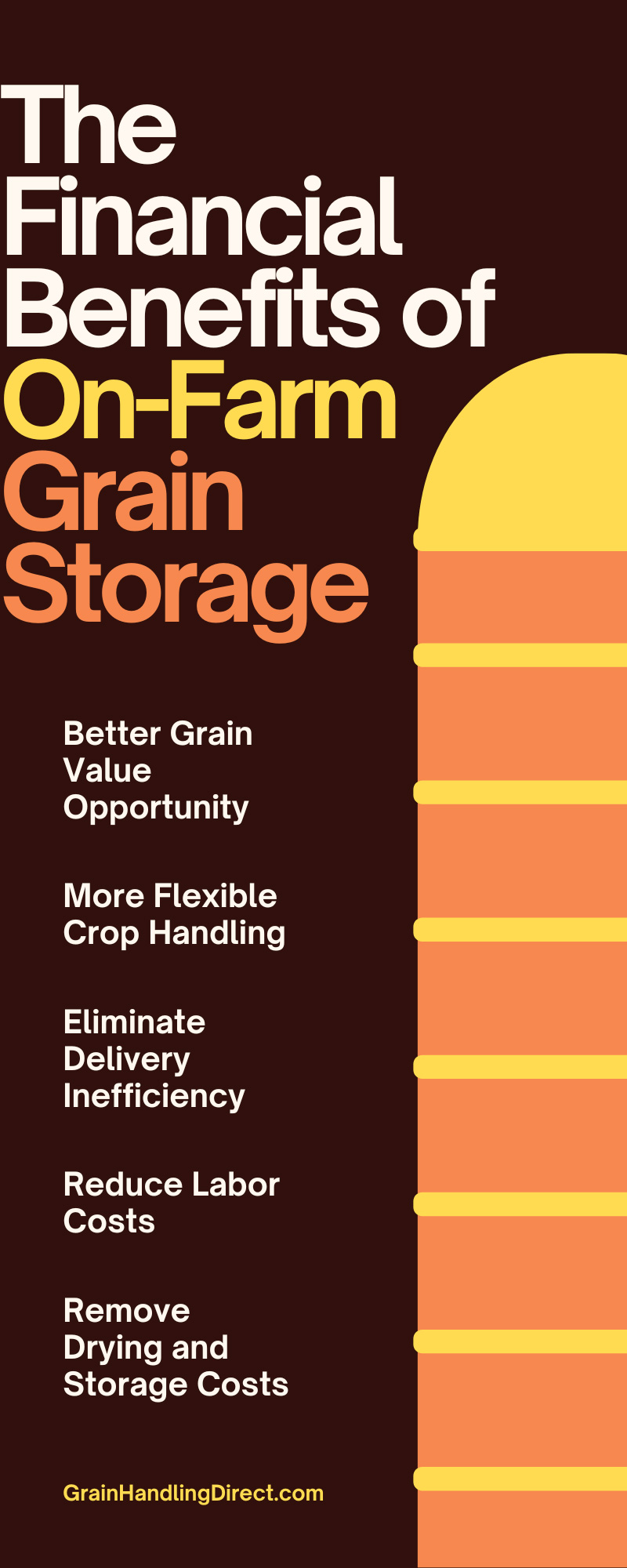The Financial Benefits of On-Farm Grain Storage
Published by The Grain Handling Direct Team on Sep 30th 2022
On-site grain storage offers farmers numerous advantages, ranging from increased efficiency to harvest flexibility. In our guide, we’ll break down some of the most significant financial benefits on-farm grain storage provides farmers and tips for utilizing long-term grain storage.
Better Grain Value Opportunity
Perhaps the most significant financial benefit to on-farm grain storage is that it can significantly increase the value of the grain. With on-site grain storage, farmers can defer the delivery of their harvest until later in the year, when grain prices increase.
Especially in the Midwest, farmers can capture significant increases in grain value if they deliver in the middle of winter rather than immediately after the harvest. Those higher values can also continue well into the summer, making grain storage a worthwhile long-term investment for big and small farms alike.
More Flexible Crop Handling
Farmers can get better value for their grain with on-site storage because the grain market is constantly fluctuating. Some of the factors that influence the grain market that is out of the farmer’s control include:
- Global trade
- Energy prices
- Global supply and demand
- Strength of the dollar
- Local and global weather
With on-farm grain storage, farmers have better opportunities to work around the fluctuations of the market that are out of their control and be more flexible with their grain delivery and futures contracts. For smaller farms, on-site grain storage helps avoid being at the mercy of a fluctuating market.
Eliminate Delivery Inefficiency
One of the farmers’ most common losses of time and efficiency during the harvest season is delivery. There are many opportunities for trucks to lose time and money for the farmers, whether it’s waiting for other trucks to unload, delays in the field, or fuel costs.
All these trucking inefficiencies can eat away at harvest profits. But with on-farm grain storage, farmers can eliminate these deficiencies with a straightforward storage system that keeps trucks moving and earning money.
Reduce Labor Costs
Labor costs are another opportunity for farmers to lose efficiency during harvest and delivery. Instead of utilizing workers to set up and transport augers during harvest, on-site grain storage with receiving systems and bucket elevators makes the process much easier and less expensive.
A well-design grain receiving system cuts down on time and resources spent on moving augers and makes for a win-win for farmers. Farms can cut down on labor costs and improve their operation’s efficiency—all with the help of some simple storage bins and receiving systems.
Remove Drying and Storage Costs
Farmers who don’t utilize on-farm grain storage use grain elevators, which are facilities for stockpiling and drying grain for long periods. While grain elevators are beneficial, they come at a price. Also, since many farms use them, this can cause delays with delivery.
Instead of outsourcing this service, on-site grain bin hoppers let farmers keep their grain under their roof, where they can cut costs for drying and storage. It may cost more initially, but it’s an example of investing in equipment and operational capacity to save money in the long term.
Decrease Combine Inefficiency
Every farmer knows that to get the maximum value and efficiency from their harvest combines, they must run practically every day from sunrise to sunset for as many days as possible. On-site storage allows farmers greater flexibility and reduces inefficiencies during harvest.
Grain History Fact: Fred Hatch, an Illinois farmer, is credited with inventing the first modern grain silo in 1873.
On-site storage makes the entire harvesting and storage operation more efficient, from the combines to the delivery and storage. With grain bins at the farm, grain producers can keep their combines running all day without worrying about delivery and storage delays.
Protect Against Unpredictable Grain Losses
As we mentioned before, the weather is an unpredictable force, but it’s also a significant factor in grain harvests and prices. Extreme weather and natural disasters can also spell doom for farms and lead to substantial crop losses.
Grain storage gives farmers a better safety net should any natural disasters occur in their local area. Even slight rain can significantly damage grain, so an in-bin drying system is another critical feature for many modern farms.
Increase Operational Value
There’s also a long-term benefit to on-site grain storage from a property and landlord perspective. If a farmer considers selling or renting their farm and land, the on-site grain storage will add value for all the reasons we’ve listed above.
On-site storage makes the farm more likely to produce a generous return on investment and gives it a more attractive value to potential buyers and renters. Even if you never think you’ll sell the farm, on-site grain storage makes it a more attractive property to prospective buyers.
Tips for Long-Term Grain Storage
Clean and Prepare Bins Thoroughly
Grain bins aren’t much use if they’re not cared for, cleaned, and prepared sufficiently. Preparing and cleaning the grain bins thoroughly is essential to protecting grain for long periods and for farmers to extract value from them.
Grain bins must be cleaned regularly to prevent insects from infesting new grain. Grain with an insect infestation could be disastrous and lead to severe losses. Some farmers regularly fumigate grain bins to ensure they’re pest-free.
Control Temperature
The temperature is integral to a grain storage system, as the proper temperature properly dries and protects grain from the elements. There are typically two ways to control the temperature of a grain bin—through aeration in the summer or temperature and heating cables in the winter.
If grain becomes too moist or cold, it can be ruined, leaving the farmer on the hook for severe losses. The exact temperature for grain depends on the region and local weather as many farmers determine their best temperature control practices, but 40 degrees Fahrenheit is usually the desired temperature.
Check Grain Frequently
As convenient as it would be to store the grain in a silo or bin hopper and forget about it, farmers should always keep a close eye on it and check it frequently. After all, it’s not just a pile of grain—it’s farmers’ livelihood!
Just checking the smell of the grain every day can help farmers prevent any moisture damage, as grain with too high of moisture will emit a noticeable odor. Experts recommend checking grain in storage weekly during the summer, if not more often. If it’s your first time using on-site grain storage, you should likely check it even more often until you’re more comfortable and experienced with the equipment.
Those are a few advantages that silos and bin hoppers offer to farmers everywhere. If you’re ready to add grain storage to your farm, Grain Handling Direct can help get you the equipment your farm needs and answer any questions you may have.


